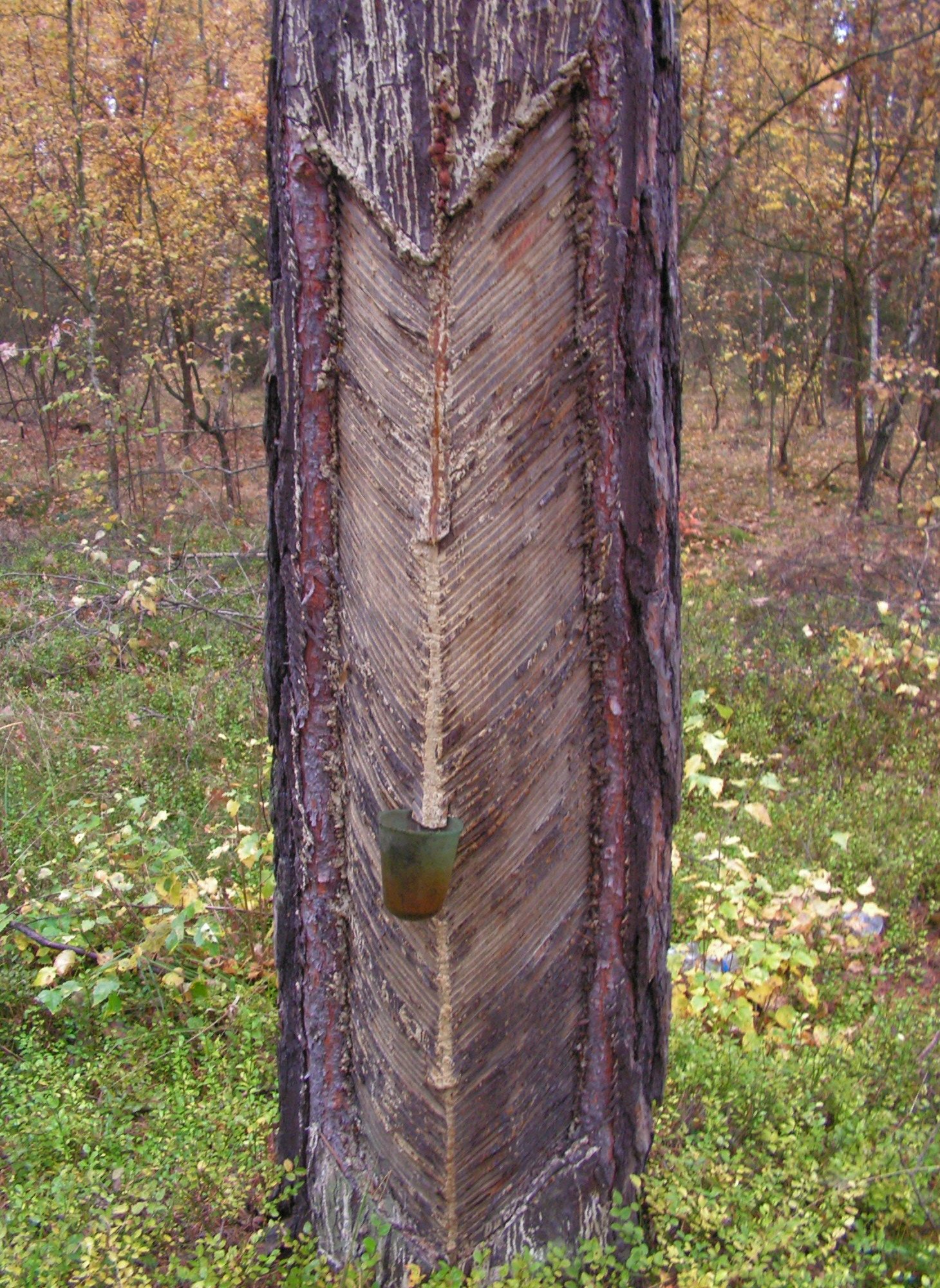resin worker on:
[Wikipedia]
[Google]
[Amazon]

 Resin workers were people whose work involved the extraction or working of
Resin workers were people whose work involved the extraction or working of
Harzer
/ref> and Pechhacker ("resin cutter").

 Resin workers were people whose work involved the extraction or working of
Resin workers were people whose work involved the extraction or working of resin
A resin is a solid or highly viscous liquid that can be converted into a polymer. Resins may be biological or synthetic in origin, but are typically harvested from plants. Resins are mixtures of organic compounds, predominantly terpenes. Commo ...
, which was needed as a raw material in the manufacture of pitch, tar
Tar is a dark brown or black viscous liquid of hydrocarbons and free carbon, obtained from a wide variety of organic materials through destructive distillation. Tar can be produced from coal, wood, petroleum, or peat. "a dark brown or black b ...
and turpentine
Turpentine (which is also called spirit of turpentine, oil of turpentine, terebenthine, terebenthene, terebinthine and, colloquially, turps) is a fluid obtainable by the distillation of resin harvested from living trees, mainly pines. Principall ...
. Resin work was an occupation that largely died out in the 19th and 20th centuries, but it was sometimes a primary occupation as well as a secondary source of income.
Terminology
As well as the general term "resin worker", the terms resin burner and resin picker are also used in the literature.France
In France, where the occupation was common, a resin picker was a ''gemmeur'', whilst a resin worker was a ''résinier''.Germany
In German-speaking lands, the general term was ''Harzer''. Other names were ''Harzbrenner'' ("resin burner")Helmut Seebach: ''Altes Handwerk und Gewerbe in der Pfalz - Pfälzerwald'', Annweiler-Qeichhambach, 1994, p.117ff in thePalatinate region
The Palatinate (; ; Palatine German: ''Palz''), or the Rhenish Palatinate (''Rheinpfalz''), is a historical region of Germany. The Palatinate occupies most of the southern quarter of the German federal state of Rhineland-Palatinate (''Rheinla ...
and ''Pecher'' ("pitcher") in Lower Austria
Lower Austria ( , , abbreviated LA or NÖ) is one of the nine states of Austria, located in the northeastern corner of the country. Major cities are Amstetten, Lower Austria, Amstetten, Krems an der Donau, Wiener Neustadt and Sankt Pölten, which ...
, or ''Pechler'', ''Pechsieder'', ''Harzeinsammler'' ("resin picker"),''Harzscharrer'' ("resin scraper")Deutsches Wörterbuch, Jacob Grimm und Wilhelm Grimm, Leipzig: S. Hirzel 1854-1960Harzer
/ref> and Pechhacker ("resin cutter").
Resin worker's craft
From ancient times resin was gathered frompine
A pine is any conifer tree or shrub in the genus ''Pinus'' () of the family Pinaceae. ''Pinus'' is the sole genus in the subfamily Pinoideae.
''World Flora Online'' accepts 134 species-rank taxa (119 species and 15 nothospecies) of pines as cu ...
s in the form of "living resin" (''Lebendharzung''). By removing bark from the tree trunk and cutting into the underlying wood, the tree was injured in order to tap into the resin that was exuded; it was then gathered and processed. Through this cutting and "bleeding", the wood of the tree became generally unusable for construction or other purposes. That was a reason why enmity existed between resin workers and foresters.
To increase the yield, carbonizing ovens (''Schwelöfen''), known in the Palatine Forest
The Palatinate Forest (; ), sometimes also called the Palatine Forest, is a low-mountain region in southwestern Germany, located in the Palatinate in the state of Rhineland-Palatinate. The forest is a designated nature park () covering 1,771&n ...
as "resin ovens" (''Harzöfen''), were used. Using wood as a raw material, resinous pine wood (''Kienholz'') was turned into resin and pitch through a burning
Combustion, or burning, is a high-temperature exothermic redox chemical reaction between a fuel (the reductant) and an oxidant, usually atmospheric oxygen, that produces oxidized, often gaseous products, in a mixture termed as smoke. Combust ...
process. The burning of resin was sometimes strictly regulated in order to prevent the wanton damage of the forest.
In the 19th century, larger and larger facilities were built to extract resin. In the Palatinate area of Germany, street and place names witness to the industry that went into decline in the 20th century (e.g. ''Harzofen'' in Kaiserslautern
Kaiserslautern (; ) is a town in southwest Germany, located in the state of Rhineland-Palatinate at the edge of the Palatinate Forest. The historic centre dates to the 9th century. It is from Paris, from Frankfurt am Main, 666 kilometers (414 m ...
and near Elmstein).
Resin was gathered in this way in East Germany
East Germany, officially known as the German Democratic Republic (GDR), was a country in Central Europe from Foundation of East Germany, its formation on 7 October 1949 until German reunification, its reunification with West Germany (FRG) on ...
until the Wende in 1990.
References
See also
* :de:Pecherei in Lower Austria * Gemmage (French) *List of obsolete occupations
This is a list of obsolete occupations. To be included in this list an occupation must be completely, or to a great extent, obsolete. For example, there are still a few lamplighters retained for ceremonial or tourist purposes, but in the main the ...
{{Authority control
Obsolete occupations
Logging